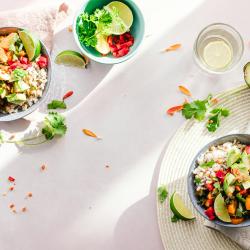How to Meal Plan for a Large Family or Group
Meal planning can often feel like a Herculean task when managing a large family or a group, but with the right approach, it can become a rewarding routine that not only saves time and money but also ensures everyone enjoys balanced and delicious meals. This article delves into practical strategies to streamline your meal planning process and accommodate the diverse needs of a large household or group.
Understanding the Basics
Before diving into meal planning, it’s essential to understand some basic concepts. Meal planning involves selecting recipes, considering dietary preferences, budgeting, and organizing shopping lists. Here, these elements need to be scaled to accommodate more significant numbers.
Step 1: Assess Dietary Needs and Preferences
-
Gather Preferences and Diet Requirements: Start by consulting with your family or group about their dietary preferences and restrictions. This may include allergies, vegetarian or vegan preferences, or specific dislikes.
-
Balance Nutrition: Ensure the meal plan accommodates these needs while still balancing essential nutrients, such as proteins, carbohydrates, vitamins, and minerals.
Step 2: Establish a Budget
-
Determine a Budget: Calculate how much you are willing to spend each week or month on groceries. Meal planning for a larger group will generally require a larger budget, but it can save money in the long run by avoiding impulse purchases and food waste.
-
Track Prices: Familiarize yourself with the cost of staple items and seasonal produce. This can help in estimating your weekly spending and making adjustments if necessary.
Step 3: Plan Meals
-
Create a Menu: Draft a menu for a week or month at a time. Start with meals that utilize ingredients you already have and include a mix of simple and complex recipes.
-
Use Themes: Consider using daily themes (e.g., Meatless Monday, Taco Tuesday) to simplify the planning process while adding variety and fun.
-
Bulk Cooking: Incorporate meals that can be made in large quantities like stews, casseroles, or pasta dishes, ensuring there are leftovers for quick reheating on busy days.
Step 4: Organize Shopping List
-
Categorize the List: Group items by categories such as produce, dairy, and pantry staples to make shopping more efficient and avoid missing items.
-
Use Technology: Consider utilizing meal planning apps or spreadsheet templates to keep track of ingredients and meals, which can be easily adjusted for changes in group size or preferences.
Step 5: Prep and Cook Efficiently
-
Prep Ahead: Dedicate a day for prepping ingredients like chopping vegetables or marinating proteins. This practice reduces cooking time and helps maintain organization in a busy kitchen.
-
Cook Together: Assign cooking tasks to different family members or group participants to make meal preparation a collective effort, fostering teamwork and relieving individual workload.
-
Utilize Kitchen Gadgets: Use slow cookers, pressure cookers, or air fryers to maximize efficiency and ease the cooking process.
Step 6: Evaluate and Adjust
-
Assess the Plan: After a few weeks, review the meal plan to determine what worked well and what can be improved. Solicit feedback from family or group members to gauge satisfaction and incorporate their suggestions.
-
Adjust Accordingly: Be flexible in adapting the meal plan to new preferences, budget changes, or dietary needs.
Additional Tips
- Stock Up on Staples: Always have a reserve of essentials like rice, pasta, canned goods, and frozen vegetables to allow for quick adjustments when necessary.
- Experiment and Innovate: Don't be afraid to try new recipes that can add excitement to the meal rotation and accommodate changing tastes.
- Plan for Surprises: Include buffer days for dining out or ordering takeout which can serve as a treat and ease the cooking obligations occasionally.
Conclusion
Meal planning for a large family or group poses unique challenges but also offers opportunities for creativity and collaboration. By considering dietary needs, managing a budget, organizing effectively, and embracing flexibility, you can create a sustainable meal planning routine that satisfies everyone. Moreover, the collective experience can enhance family bonds or group cohesion while fostering a sense of shared responsibility and joy in the kitchen.






















